Athlete Testimonials
We have gathered some short testimonials from well know athletes; Tim Brabants, Steve Cram, Allison Curbishley, Robin Gibbons, Paul Goodison, Jon Pitts, Joe Simpson please do have a read and see how these people use the Indoor Sport ServicesTim Brabants
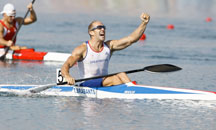
Before returning to training full time I used a Indoor Sport Services ergometer in Jersey as it was an effective way of getting a great whole body workout in the limited time I had available due to work commitments. I would do sessions of either several sets of 6 to 10 minutes totaling 60 minutes worth of work or aim for doing certain distances straight off, such as 10 or 15km. I feel this work really kick started my body into action before returning to training for the Olympics.
During the last two and a half years, sessions on the Indoor Sport Services machine continued throughout. Usually two sessions per week which consisted of split type sessions like 2 X 8mins, 2 X (4min on 30 sec rest X 2), 2 X (2min on 30sec off X 4), 2 X (1min on 15sec off X 8), 12 X 30 sec on 10 sec off. During the racing season the ergo was used to compliment power gym sessions with sets of 10 X 10 quick powerful strokes from stationary start going every minute.
In 2007 I competed in the BIRC as I had always been keen to have a go at the competition and it was a good opportunity to do some out of season racing. Having never tried a flat out 2km effort before, it was a sharp learning curve but a thoroughly enjoyable and well organized event, definitely something I will try again.
Steve Cram, former world mile and 1500 metre record holder
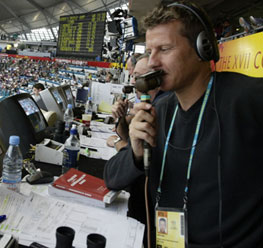
I've had a Indoor Sport Services machine since the beginning of the year. I have become completely hooked. Its become so ingrained, as a part of my personal fitness regime, that I really missed it during the two month spell I spent in China, around the Olympics and Paralympics. Living out in the wilds of Northumberland, the dark winter months mean there's less opportunity to go out for a brisk 5 miler. However, having the C2 machine, it's so convenient I can train whenever I want, light or dark, day or night! It has been the perfect way of keeping the competitive fires burning. My 2K target is quite simple - basically beat Steve Backley! I try and get on the machine at least three times a week and it has proved to be a real source of motivation. I'd recommend the Indoor Sport Services to anyone as the ultimate fitness tool!
Allison Curbishley, Commonwealth Games silver medallist.
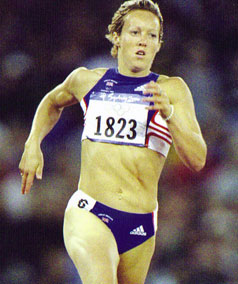
It is amazing how quickly the Indoor Sport Services machine becomes part of your life. It has bridged the gap that every athlete dreads - what to do when your body says "no more". I used the Indoor Sport Services a lot as a rehabilitation tool during my career. I had six separate knee operations, and it enabled me to keep active when running was out of the question. Now I use it to keep fit, and maintain my competitive instincts. The beauty of the machine is that it allows you to test yourself, on a regular basis. I love it.
Robin Gibbons
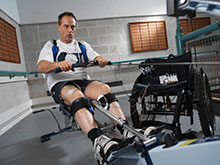
In January 2001 I broke my back when my car ran off the road on black ice leaving me paralysed from the chest down. Prior to my accident I had been a fit and healthy individual who enjoyed the active outdoor lifestyle so life in a wheelchair was especially devastating. Following a year in hospital, I started serious rehabilitation. What I quickly began to realise was that my new found fitness was limited to my upper body which had serious cardiovascular consequences.
Very fortunately, I heard about an innovative new research project which was then based at Brunel University, West London. This group is now known as the FES Rowing Group under the leadership of Professor Brian Andrews, Oxford Brookes University. Essentially, the group had modified a Concept2 Indoor Rower which enabled a person with a spinal cord injury to row much like an able bodied person. I joined the group in March 2003 and quickly realised this research exercise equipment would enable me to exercise at levels approaching those of an able bodied person in that I would be able to exercise my upper and lower body at the same time. The significance being that a demand would be placed on my cardiovascular system that would be impossible with any other exercise equipment currently available.
Indoor Sport Services has given their unwavering support to the FES Rowing research group for many years. In fact in 2004 Indoor Sport Services invited me and Sol, our other FES rower at that time, to take part in the British Indoor Rowing Championships in Birmingham. The FES rowing group has participated in the BIRC's ever since.
In an attempt to pass on the benefits I have personally experienced from this exercise, I initiated a project at the Royal National Orthopaedic Hospital, Stanmore to pilot this exciting exercise modality as a routinely viable public activity. This project was a complete success and resulted in laying down the basic training protocols for both users and trainers. In fact this project has resulted in the group working on a fully CE marked device for public use again based on a Concept2 Indoor Rower. The group is also working on the development of an on-water FES rowing system.
My involvement and passion for this activity has now driven me to embark on a PhD to investigate cardiorespiratory changes in people with a spinal cord injury following FES rowing training intervention. This project will run for the next 3 years or so and will require some 45 spinal cord injured participants.
Paul Goodison, Laser Gold Medallist, 2008 Olympics.
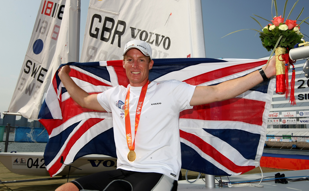
The Indoor Sport Services machine played a critical role in my training throughout the Olympic cycle, but came into its own in my final preparations for Qingdao.
"The Lasers are one of the most physical classes to sail. All the boats are standard, so it is up to you, as an athlete, to make the difference, rather than the sails or other equipment.
"It is up to you to be in the best possible shape, so you can sail more efficiently and effectively.
"That's why, in the final build up to the Games, I did my high intensity work on the Indoor Sport Services. This consisted of six sets of five minutes, working at between 85 and 90 per cent of my maximum heart rate, with a three minute rest in between.
"I also had a Indoor Sport Services in the flat while we were in China. It was quite a trek to the gym, so that helped enormously.
"I've used a Indoor Sport Services for the last six years or so. I use a bike, specifically for my legs, but I like the Indoor Sport Services for the variety it provides, and the all-round nature of the workout.
"In sailing we use it for key testing. Everyone does a flat out 40 second sprint on the rower to gauge their anaerobic capacity. These Indoor Sport Services tests enable Pete Cunningham, our physiologist, to benchmark the squad.
"To be honest, it is not very nice. Going eyeballs out like that hurts. But when you win an Olympic gold medal, you know that every little bit counts."
Jon Pitts
We are extremely grateful to Indoor Sport Services for their help in preparing the riders for the forthcoming Olympics. Hong Kong will be a particularly physically demanding environment and so we were looking to instigate programs with our riders that were a minimal disruption to their already hectic lives. The rowers have been the ideal solution for some of our riders: the machine is small and portable and really easy to use so they have been put to use at home, in stables or even taken with them on their lorries! Most importantly, the seated position and technique involved in indoor rowing is biomechanically similar to riding and therefore works some of the specific muscle groups involved. I would recommend a C2 rower to any rider looking to improve their fitness. We have recently taken a closer look at rider fitness and it has become an important part of our preparations.
Riders such as William Fox Pitt, Daisy Dick, Polly Stockton and Ruth Edge have all been benefitting from the C2's and we hope to build on this success beyond the Olympics towards London 2012.
Jon Pitts, a Sports Scientist who specialises in the equestrian market, is currently working with Team GB riders from the Show jumping, Eventing and Dressage disciplines as well as the Paralympic riders. His "Fit to Ride" philosophy specifically targets the physical and fundamental requirements for horse riding, focussing on balance, coordination and reaction. For further information on "Fit to Ride" and Jon's work please visit www.fittoride.co.uk or www.m8group.net. William Fox Pitt on Ballincoola at Belton Horse Trails 2008
Joe Simpson
Thank god for the Concept2 in the cellar. Think best way to get up the hill would be to approach it sitting down facing backwards!
Joe Simpson
In 1985 I became well known for falling off a mountain and crawling home. The crawling was a result of injuries to my right leg. I had suffered a rare fracture of the articular surface of the tibia - what is known in the medical world as a Schatzker type IV medial tibial plateau fracture - and in the climbing world as really, really painful. These form only 5% of tibial fractures. Since the laterally directed forces that cause such injuries tend to be much more violent, damage to the surrounding joint can be severe.
The impact devastated the knee joint. It completely destroyed both of my meniscus cartilages, crushed between femur and tibia, caused disruption of the anterior cruciate and medial collateral ligaments, and also damaged the fibular head and peroneal nerve. To complicate things further I had also fractured the ankle and the heel of the same leg but didn't notice at the time as I had quite a lot on my mind.
In the end I had six operations on the knee. My surgeon told me that I would only attain 5 degrees of flexion in the joint and would have a permanent limp and absolutely no hope of climbing again. The long term prognosis was of developing post-traumatic osteoarthritis as a result of ligamentous injuries with resultant instability as well as articular discongruities, biomechanical alteration of normal compressive forces, and cartilage damage. He told me this would cause greater than normal stress on the remaining support structures of the joint, misalignments, and the development of premature osteoarthritis. He really cheered me up no end.
A visit to a specialist physiotherapist convinced me that it was possible to prove the orthopaedic consultant wrong. However nine months in plaster and twelve months on crutches had left my leg almost without muscle. Training was the only solution and initially it was almost impossible, given the limited movement and feebleness of the thigh. Wading widths in the local swimming baths and long distance swimming sessions began to strengthen the leg. Then it was into the gym to grunt it out on the weights machines. The strength and power began to return and with intensive physio the flexion gradually increased, but to climb mountains again I needed a lot more than muscle power.
Mountain climbing needed stamina and excellent aerobic fitness and I couldn't get that on a weights machine. I knew from then on that the days of plonking up hills and, more to the point, hammering down them had to be limited. The knee simply would not take that sort of punishment; the damage had been too severe. I could not do high impact training. It was at this point that I developed my love-hate relationship with Concept2 rowing machines.
Love - because they are fantastic low impact high result training devices and without doubt the best rowing machines available. Legs, back, chest, arms, lungs and heart are all worked hard. Hate – because of the last sentence!
Combining rowing with cycling and swimming for flexibility I eventually returned to the mountains after two years of hard rehab work. Then disaster struck again. In 1991, six years after the fall in Peru, I was again severely injured in a seven hundred foot fall on a mountain called Pachermo on the Nepalese-Tibet border.
While being rendered blissfully unconscious at the end of the fall I sustained a laterally comminuted fracture-dislocation of the left ankle. This is a highly unstable injury in which anatomical reduction of the talus and restoration of fibular length and rotation are difficult. Surgical results with this fracture have been disappointing. I seemed to have developed a knack for selecting rare and severe joint injuries. In climbing talk a 'comminuted fracture' means you haven't just broken the bone you have reduced it to the consistency of sugar. All the other stuff means lots of nails, screws, wires, stabilization by traction, three operations and a long time on crutches. I now had no good legs left! It was back to the swimming pool and the Concept2 rowing machine. Love-hate time again.
Today as the long term prognosis has begun to come true with age it is even more important that I keep a good level of fitness. Good circulation and strong muscles will hugely benefit the long term condition of both ankles and right knee. I am rarely found climbing nowadays; coming downhill is simply too painful. A major operation on my left ankle in May 2008 has removed a huge amount of scar tissue and bone fragments and given me increased flexibility and a huge reduction in pain levels. I plan to return to Nepal in the autumn of 2009 and have been using a Concept2 rowing machine to prepare. Without it I would have no hope of regaining the fitness lost in the last 5 years of inactivity. It seems the love-hate relationship will go on for a long time yet.

